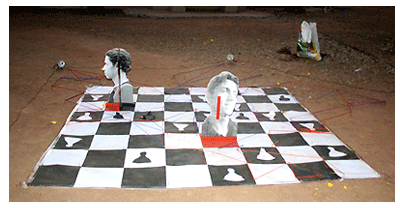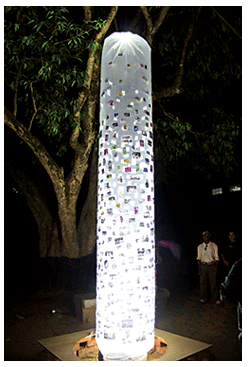10 Inspiring Names in the Realm of Art, 08/03/2021
Emran Sohel
Sitting at the top floor of the Panthapath Pathshala and listening to Emran Sohel ardently talk about his artistic oeuvre was a fascinating treat to say the least. Starting from blissfully discussing about his devotion towards Dadaism to diving deeply into the politics of performance art, Sohel does it with a masterful precision yet with a sense of unbridled passion.

Born and raised in Dhaka, Sohel’s academic journey in the field of arts started with Rajshahi Charukola, from where he went to Santiniketan to finish the rest of his undergraduate and his master’s program in fine arts. “At Bangladesh, we played the roles of a student more than that of an actual artist. We painted day and night without a second thought on our minds. However when I went to Shantiniketon, it seemed as if nature seeped into the landscapes spectacularly and I got a chance to experiment with my style more, I finally got to strike up a dialogue with my canvas and the concepts I wanted to explore. It was liberating beyond belief though a tiny bit intimidating” Sohel said with a laugh.
Going through Sohel’s numerous compositions, one can find a politically charged postmodern taste to it, his performance pieces are unnerving it their radicalism and dry wit. One of the recurring motifs in his works is something intangible — his creative use of space. Sohel talks about his exhibit at Chobimela and how it took place spanning over the entire space of the fire exit of the building and then goes into a detailed depiction of one of his first exhibitions — “A friend of mine and I covered our bodies in a solid shade of colour, painted our cycles as well and then we travelled around the entire area of Shantiniketan.” Sohel adamantly mentions that his vision deals with the many shenanigans of public spaces and he does not want to create art on a canvas but enlarge his canvas which is why installation pieces and performance pieces are his preferred genre.
On the topic of his further explorations, Sohel tells us “For commission work, I am constantly working on intricate face sketches and portraits, but for my personal exhibitions, I work with different medias—and try and sculpt a ground which is relevant and which sings a song of needed defiance” Sohel says. The tales which Emran Sohel has crafted so meticulously holds a sense of versatility that at once screams rebellious, postmodern kitsch but also has a supremely sombre tone etched alongside it, a tone that seems like an absolute necessity in these trying times.
ART news & views
The Presence of Past a New Media Workshop
Volume: 3 Issue No: 15 Month: 4 Year: 2011
by Jamsheed Malik
It is perhaps more important today than before that we review our relation with the histories we are blessed with. What is needed- especially for artists and academicians- is an awareness of the present through critical and creative thinking. An attempt in this direction was made through a week long workshop at Kala Bhavana, Santiniketan, between March 1st and 8th, 2011. The Presence of Past was the theme of the workshop. Seven practitioners were invited as resource persons to Kala Bhavana by the coordinators Sanchayan Ghosh and Parvez Kabir. Each artist was joined by 15 to 20 students who jointly explored and worked around the theme. The theme was not meant to limit the discourse but act as a starting point from which the artists could flexibly take any course. It was completely on the artists how they would deal with it.
The workshop gave us an opportunity to explore how we respond to and use images from visual history, and how techniques and mediums of art making carry historical associations.  Artist- Emran Sohel
Artist- Emran Sohel
We also explored how our social and personal histories shape our identities.
Rakhi Peswani, who is from Hyderabad, pointed out to her group something very basic within the students’ own practice; their shortcomings or lacking that might be hampering their art practice. It could be skill related to writing, painting, drawing or any other medium. The students were not expected to just make a work of art but also to clear the clots within their minds.
Vasudha Thozhur who presently lives and works in Baroda, began interaction with her group with a short presentation of her works and some public projects she had done. Students showed their works to her and through discussions came up with the idea to choose elements from their early works and create a new art work. The group concentrated on issues related to their art practice from the past which were still unresolved. Visual grammar was given the most importance.
Subodh Kerkar, a Goa based sculptor and installation artist, began the workshop by discussing his work with his group. The idea was to give students an introduction to the practice of installation art. The students took the memories of their past to another level by installing some wonderful earth works in the open spaces of Kala Bhavana.
Tushar Joag, from Mumbai, started his group work with what he called “some mental aerobics”. As an exercise, he asked his students to look at a visual model for history. The students were asked to consider history not as a straight line or loop or many parallel lines but a more three dimensional representation, where the past and the present collide. They decided to work with vehicles. The vehicles travel towards an intersection and collide with each other and the explosion creates a new hybrid vehicle POP 005 (Presence of Past 005).
Bangalore based Umesh Madanhalli who is a performance artist, believes that even if a person is not skilled as an artist, they can be discerning observers of art and develop a good taste. He proved his point by having his group hand out sumptuous dishes at the end of each working day, where the creator and the consumer freely shared opinion about the dishes. As a performance, his group also walked backwards from the Museum, through the Kala Bhavana premises, and ending up at the chatal, the raised platform for performance, as an expression of traversing the history of Kala Bhavana.
artist, they can be discerning observers of art and develop a good taste. He proved his point by having his group hand out sumptuous dishes at the end of each working day, where the creator and the consumer freely shared opinion about the dishes. As a performance, his group also walked backwards from the Museum, through the Kala Bhavana premises, and ending up at the chatal, the raised platform for performance, as an expression of traversing the history of Kala Bhavana.
Vipin Vijay, a filmmaker from Kerala, and a student of Satyajit Ray Film & Television Institute, started his group with an introduction to camera techniques. Then he asked his students to take anything from their memory and prepare scripts for it, in a way so that they could make it in one frame. Students went around the campus and other local places to shoot videos and take photographs. Finally, they came up with some very innovative experiments with frame and camera.
Manjari Chakravarti’s group came up with the idea of using boxes of memory as a tool for negotiating their past with the present. So, a movie box, a pitcher, a vase, a tray, a stationery stand, and even a fan were conceived of as a ‘box’. The odd participant also felt that memories could not be contained within such physical boxes, and he supported his arguments with a video. Thus, dialectic was created within the group, and between the notions of the possibility as well as the impossibility of expressing oneself with the given materials.
At the end of each working day, the resource persons would give presentations of their oeuvre on a projector screen, which would be followed by discussions and question-answer sessions.